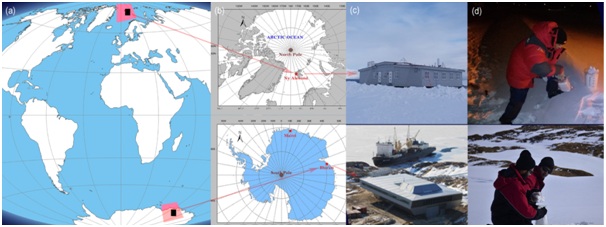


Long-term monitoring of atmospheric aerosols and their interaction with radiation, cloud, and cryosphere over the Arctic and the Antarctic are very important for the global climate change related issues. In this regard, for conducting aerosol measurements, India has extended the concerted efforts to the Svalbard region of the Norwegian Arctic in the northern hemisphere and the Larsemann Hills of coastal Antarctic (Bharati, 69°24.4′S 76°11.7′E, 40m a.s.l.) in the southern hemisphere.
The Indian Arctic station Himadri is a part of the international Arctic research base, Ny-Ålesund on the island of Spitsbergen in the Svalbard archipelago, close to the Zeppelin Mountain and at the coast of Kongsfjorden. This is the highest latitude (northernmost) location easily accessible beyond 78°N. The geographical position of Ny- Ålesund further enables the observations of climate relevant parameters in the boundary of ocean, land and atmosphere. The high latitude position of Ny-Ålesund also allow monitoring of background values of trace substances, as well as investigation of physico-chemical transformation processes of air mass characteristics. The climate of Ny-Ålesund is tundra in nature having average annual temperature of −5.2 °C. July is the hottest month of the year with an average temperature of 4.4 °C and March is the coldest with an average temperature of around −12.7 °C. The amount of precipitation peaks in September, with an average of 46 mm, while the month of May receives an average precipitation of 18 mm.
The Indian Antarctic station 'Bharati' is located in Larsemann Hills (coastal hills along the south eastern shore of Antarctica) having a natural topography of rocky granite very near the open ocean. Since the first visit in 1935 by a Norwegian team, Larsemann Hills have always been the pristine region of scientific interest and tourist attraction, where the rapid development of infrastructure and sporadic ship-based tourist visits have been made since 1992 (Measure-15, 2014 - ATCM XXXVII). Being in a relatively undisturbed state, much of the scientific research in the LH reflects the natural environment, benign microclimate and the Antarctic life forms. The general climatic feature of LH is the persistent katabatic winds which are predominantly north-easterly during the summer (December to February) seasons. During these days, daytime air temperatures frequently exceed 4 °C with the mean monthly temperature remaining above 0 °C. During winter, monthly mean temperatures mostly range between −15 °C and −18 °C. Precipitation (snowfall) remains below 250mm water equivalent annually. Snow cover in the LH persist in most summers and is generally deeper (thicker) on Stornes Peninsula (close to Bharati) than Broknes Peninsula (Vasudevan, 2015), where the stations of Australia, China and Russia are located. Throughout summer, the ice pack is extended to inshore, even the fjords and bays are rarely ice-free.